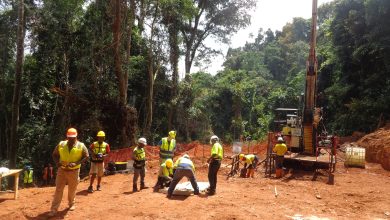
Absence Management for Mining Operations
Effective Absence Management, Increased Profitability
By reducing absence levels significantly, mining companies can register a rise in productivity, and concurrently profitability. But mining management needs a fundamental attitude shift in their approach to absence management. This is the sage advice from Soma Initiative (Pty) Ltd, providers of Soma iKon™, an absentee management solution.
In South Africa, government-aligned labour unions, like-minded bodies and some academics have been pressing for a basic minimum wage, better working conditions and other benefits for employees. Mining companies, as one of the biggest employers, are among businesses that have been pilloried the most for their alleged indifference towards attending to these pressing issues. Arguably, this may hold water. However, on the flip side, what may be overlooked – deliberately or inadvertently – is the burden the implementation of the demands places on employers. Sometimes, a fact that is lost on critics or commentators is that mining houses are first and foremost running businesses, which have to make a return on shareholder investment, and the rest, much as it is presented otherwise, is secondary.
As a rule, the provision of improved employee conditions is directly correlated to an increase in productivity. In other words, improved employee conditions and an increase in productivity are mutually inclusive. The significance of this is that productivity affects the bottom line as it impacts upon revenue. For this reason, mining companies have to adopt practices that can help them increase (or sustain) productivity. So, what about the employee side of the bargain?
One area, easily within the mining houses’ grasp, where new approaches to productivity management can be explored is in managing employee absenteeism, one of the main causes of poor productivity.
Effective employee management
Effective employee absentee management is one of the ways that mining companies can increase productivity. This is the sage advice of Soma Initiative to mining houses in South Africa and the region. This is based on the company’s experience as a provider of a wide range of customised human resources management solutions to diverse industries.
Marianne Lancefield, Project Manager for Soma Initiative’s Absentee Management Programme, Soma iKon™, acknowledges that every organisation has a standard way to manage employee absenteeism. However, the level of reliability, and thus effectiveness of the absenteeism management, is questionable.
To underscore the importance of employee management in organisations, Lancefield illustrates how the neglected elements at the micro-level (within organisations) can have huge implications at the macro-level (national economy). Based on this, she suggests that there is need for a fundamental shift for mining companies to manage this challenge.
At the outset, it is important to define employee absenteeism in this context.
The scope of absenteeism
Absenteeism is not limited to sick leave. Its scope spans all unscheduled leave, including early departures from and late arrivals at work, feigned illness, attending to private affairs during working hours and such “absence”.
Thus, from this viewpoint, Lancefield explains that the realm of absentee management covers identifying, monitoring, and significantly, addressing absentee issues within the framework of the law, collective agreements, employment contracts and organisational policy. “Through absentee management, employers are empowered to manage their most vital capital, human capital, and in the process to reduce costs, boost productivity and profitability. Employees too are rewarded as their attendance promises potentially greater financial reward and more importantly, security of job tenure.”
Impact of absenteeism
The scale of the impact of absenteeism on the economy may be underestimated. But the reality is that it is far-reaching. Based on present economic conditions, it is an issue worth confronting head-on, rather than wishing away. Presently, the country is facing record youth employment of 67% and unemployment of 34.5% (in the first quarter of 2022, based on Stats SA).
Intriguingly, in any discourse on frightening unemployment figures, the focus is biased toward the ‘visible’, the macro-level. However, in the course of this, the critical smaller details – the critical micro-level issues – within organisations may be ignored. Chief of them is productivity, on which employee absenteeism has a considerable impact.
Citing alarming statistics, Lancefield laments, “Those fortunate enough to be employed in South Africa cost the nation an estimated R38 billion per annum in direct sick leave costs [Momentum Effective Employee Index, September 2021]. Unscheduled absence in some industries runs at 15% – 15% of the time scheduled to be spent at work, is lost through absence according to Occupational Care South Africa (OCSA). This may be extrapolated into losses of about 36% of annual payroll and 20% of man-days through absenteeism [Mercer: The Total Financial Impact of Employee Absences, October 2008].”
Another factor worth pointing out is that against the backdrop of unattended absenteeism is a persistent economic paradox, a dichotomy. On the one hand, on the micro-level, there are profit and productivity pressures, and, on the other hand, on the macro-level, unemployment, and GDP pressures. “We have the unemployed crying out for jobs, and we have the employed not fulfilling their employment contracts,” Lancefield points out.
The compelling case for effective absentee management
From the abovementioned, given the epic crisis of unemployment, there is a compelling economic case for reducing absenteeism. Okun’s Law of Economic Production posits: GDP needs to grow by some 4% in order to reduce unemployment by 1%. Clearly, considering the unemployment rate of 34.5%, there is work cut out – the nation needs to grow.
Realistically, there is no ‘quick-fix solution’ to saving jobs, contrary to what trade unions and populist politicians may pontificate. “We can only grow our economy by producing. We can only produce by being at work and working. We need to get the employed ‘working’. Then, perhaps we can produce more jobs for the unemployed,” asserts Lancefield. “Employers can boost their profits by attending to productivity issues. They need to get the workers back to work. They need to manage their absenteeism. If absentee levels are managed, productivity rises and so does profitability. In general, as Soma Initiative, our stance is that if we attend to the absenteeism issue, we can do both: save the jobs we have and create new ones, too.”
Fundamental mindset shift
In the end, the rewards of improved absenteeism management are immense – organisations grow, and they can make further investment in the business in the form of, inter alia, creating further employment, and employee skills development. Evidently, the onus is on organisations to tackle absenteeism – most importantly, there is a need for a fundamental shift at the management level on how best to manage it and the human resources and operations units.
Side Bar 1
Case study at a mine
Recently the team at Soma Initiative conducted extensive research on the impact of employee absenteeism at a mine in South Africa. The findings indicated that the biggest oversight was the grey area of the responsibilities of both the human resources and operational teams.
At the mine, each of these units worked in silos, disparately, inevitably leading to undefined and poorly demarcated areas of responsibility. Unsurprisingly, there was poor management and control of absenteeism; neither team being ultimately responsible for absence management. In addition, there was neither data nor information to enable informed decisions to address the problem.
To manage a challenge of this nature, Soma Initiative suggests that mining companies should have access to actionable data and information and should consolidate their approach by creating clearly defined lines of responsibility.
Actionable data and information enables timeous management of the workforce as a whole. This particularly applies to mining companies as they comprise 1000s of employees who disseminate in a number of shifts each day into several small operational teams within a number of shafts. And so, rapid, and accurate real-time data and information should be a critical component of daily absence management as is the accessibility of historical data in respect of employees’ behaviour, illnesses, sick leave patterns and trends. In the same vein, the provision of relevant reports and the ability to analyse pertinent data are essential in workforce management. Without such and the willingness of the responsible parties to manage, effective management of absenteeism is doomed.
Side Bar 2
Soma iKon™ – SOMA’s absence initiative
Based on the current challenges that industries face managing employee absenteeism, Soma Initiative (Pty) Ltd has devised a solution. Sophisticated but highly cost-effective, Soma iKon™ is a web-based software application that functions parallel to any time and attendance and/or HR programme and is customised to allow for client-specific data mining and information reporting.
There could be a dime a dozen apps that are tailored at helping industries manage employee performance, but what makes Soma iKon™ stand out is that it delivers targeted, employee-specific, management information and instruction.
Highlighting standard absentee management programme functionality, Lancefield says, “It is the generation of crucial management information out of raw data by Soma iKon™ which facilitates the effective and efficient, in-house or outsourced, management of inappropriate employee absence.”
Soma iKon™’s scope of critical features that enhance absent management include:
- Automated real-time notification of (imminent) company policy and/or labour legislation contravention by specific employees
- Automated, real-time reports identifying incidents of culpable and innocent absence
- Contravention-specific intervention management instruction
- Standardized requisite record letters and forms allied to intervention management (return-to-work, leave application, counselling, formal and informal warnings)
- Medical Certificate management: validation, verification, and capture of medical certificates received by Soma from the client. Medical practitioner liaison for confirmation of accuracy and appropriateness of medical certificate detail, when deemed necessary.
- Ad hoc telephonic “hotline” consultation facility for backup advice, guidance, and instruction on absence management
- Ad hoc on-site case management or problem consultation provision by specialist Medico-legal Consultants
- Contracted on-site, Soma-sourced intervention management by shared or dedicated, roving or permanent, specialist Absentee Management Consultants to conduct return-to-work interviews, counselling sessions and to advise and guide on absence management and disciplinary issues where required.
Soma’s offering is flexible and tailored to be client-specific. It has two options – either the client can use Soma iKon™ to manage absence independently or in a consultative alliance with Soma iKon.
Generally, the main benefit of Soma iKon™ is that it facilitates focused, goal-directed absence management. For instance, it helps industries manage the common problem of having a technically skilled and knowledgeable employee who lacks requisite people skills and knowledge and human resources management training to manage absenteeism. In this way, it presents a significant opportunity to boost organisation performance and productivity.






